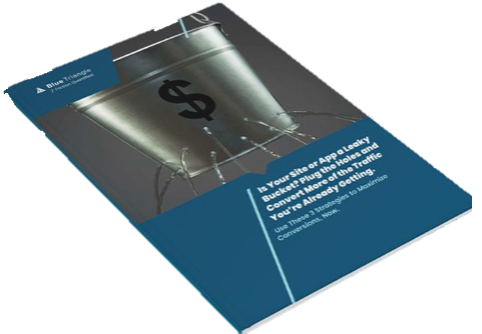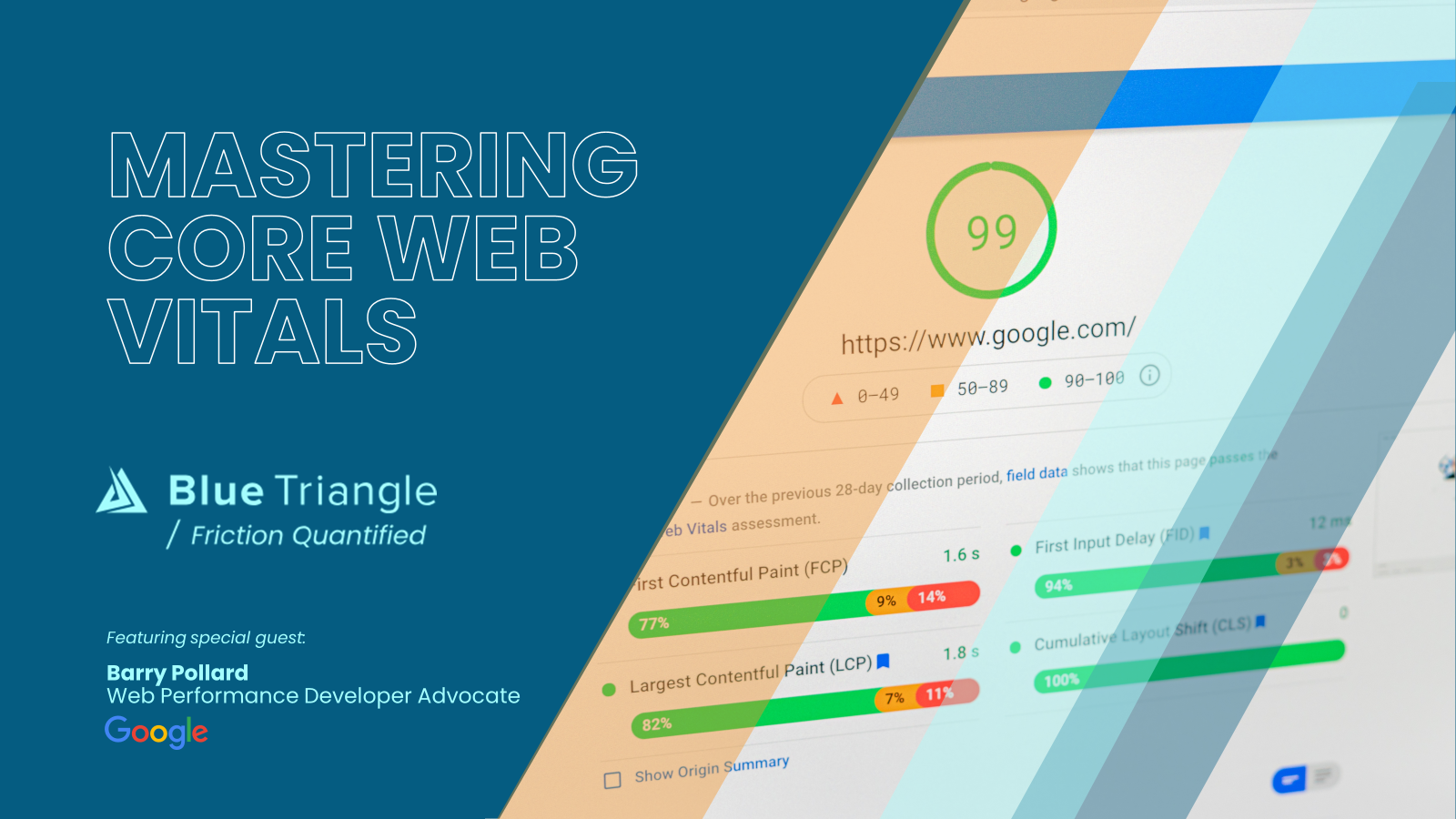Interaction to Next Paint (INP): Does it Really Matter? Here's Everything You Need to Know
No one likes friction in their digital, physical, and phygital user experience, including Google.
Core Web Vitals (CWV) have become key metrics for digital and business teams to track and improve site performance, ensuring users receive the best experience possible. It also affects your SEO and search engine rankings and correlates with business metrics.
Nick Paladino, Director of Product Engineering and Co-Host of The Frictionless Experience, says this about Core Web Vitals:
"Google adding SEO as a consideration with Core Web Vitals helps create better website experiences. What I find very cool about Core Web Vitals is that it's pretty much the first time we've been able to quantify the user experience. Because the interactivity of INP matters a lot. The stability of the site matters a lot. And that's what helps us to make sure that we're doing right for our customers."
What are Core Web Vitals?
Google Core Web Vitals focus on user experience, painting the picture of a user arriving at your site, waiting for content to load, and then interacting with that content.
Specifically, the currents CWVs are:
- Largest Contentful Paint (LCP) measuring loading performance.
- First Input Delay (FID) measuring interactivity.
- Cumulative Layout Shift (CLS) measuring visual stability.
Nick Paladino describes each aspect as "a trinity of user experience" that all teams, even business leaders, can understand and get behind to ensure a frictionless customer experience.
Interaction to Next Paint (INP) will replace FID as the primary metric for measuring page interactivity.
While this change becomes official in March 2024, Blue Triangle already collects INP data for customers and highly recommends organizations track INP now to enhance the user experience and future SEO and business outcomes.
What is the business impact of Core Web Vitals?
Many companies often prioritize adding functionality over site performance and user experience improvements, creating unintended friction and costing customer trust and loyalty.
Core Web Vitals break through this line of thinking by creating a common language for all stakeholders to focus on user-centric metrics and invest in frictionless experiences that drive business growth. By changing the conversation around performance and experience and relating it to revenue and business outcomes, you can help create a company culture of Continuous Experience Optimization.
Commenting on Core Web Vitals, Mike Lively, SVP of Engineering at Slickdeals, says:
"It's the first time we have measurements that actually truly reflect user experience. It definitely raises the bar for what you need to do to be successful from a user experience and performance perspective. But at the same time, it set a clearly understood bar that where you knew if you met it, you're actually truly making a difference for your users."
Here are a few examples demonstrating the business impact of Core Web Vitals:
- For instance, we've seen firsthand how product pages can see 40% to 50% lower conversion rateswhen comparing users that experience a 2-second Largest Contentful Paint (LCP) vs. a 4 to 5-second LCP.
- When one of the largest media companies in Japan, with more than 22 billion monthly page views, optimized their site's Cumulative Layout Shift (CLS), they saw 1% more page views per session.
- Then, there's Interaction to Next Paint (INP), officially replacing First Input Delay (FID) as a Core Web Vital in March 2024. When the world's largest online bus ticket booking brand set out to improve this relatively new user-centric performance metric, the result was a 7% increase in overall sales.
The Google Chrome Dev Team puts it best when sharing why popular brands invest in Core Web Vitals and how it benefits their business and consumers:
"Regardless of the amount of time spent, decision makers should treat this as a long-term investment into growth of their business. Delivering a fast and seamless navigation experience delights users and helps turn them into loyal and returning customers. For product managers, performance should be an important criteria that defines the quality and success of new product features. And product excellence and working on interesting challenges improves developer satisfaction as well."
What is Interaction to Next Paint (INP)?
INP is a new metric to measure overall responsiveness on a website to user interactions (clicking with a mouse, tapping a touchscreen, or pressing a keyboard key) that occur throughout the lifespan of a user's visit to a page. The final INP value is the longest interaction observed, ignoring outliers.
To learn more about Interaction to Next Paint, check out this Blue Triangle Help Center Article.
Why is Interaction to Next Paint replacing First Input Delay?
First Input Delay (FID) only accounts for the first interaction, whereas INP considers all page interactions. FID also only measures the first interaction's input delay, not the time it takes to present the next frame. That's why FID is considered your page's first impression.
But data shows that 90% of a user's time on a page is spent after it loads, which is what INP assesses. Since it takes into account all interactions, INP goes beyond first impressions and is a more reliable indicator of overall page responsiveness.
What does this change mean for website and business stakeholders?
Although 93% of sites have a good FID performance on mobile devices, only 65% have a good INP score. So, there's considerable room for improvement. The good news is that any improvements previously made to optimize FID will serve as a solid foundation to improve INP and ensure a more responsive experience.
The best time to start measuring your website's INP is now! And the key is continuing to improve it.
When you focus on the user, all else will follow. By providing an optimal experience, you'll not only delight users but also reap the financial benefits of a frictionless experience.
How does Interaction to Next Paint impact the customer experience?
While understanding Interaction to Next Paint is essential, does it correlate with how users interact with your site? This is the most critical question we should be asking as it'll inform if improving INP will impact customers, and thus your business.
It's easy to focus so intently on improving metrics, such as Core Web Vitals, that we lose sight of the bigger picture: creating a frictionless user experience.
The below example shows how slow responsiveness, which INP measures, can cause friction and user frustration.
Source: https://web.dev/articles/inp
Optimizing INP is not only a metric that Google takes into account for better SEO and search engine rankings, but it also improves the user experience.
"INP is aiming to improve the web by surfacing frozen, glitchy, poor experiences. So, although you have until March 2024 before INP becomes a Core Web Vital, your users are experiencing these sub-optimal issues right NOW, so it is something you should look at," says Barry Pollard, a Google Chrome Web Performance Developer Advocate.
We were fortunate to have recently sat down with Barry for his opinions and recommendations on how Google measures user experiences and site performance, including:
- How performance is not a single number.
- Why just having the CWV score is not enough.
- The value of RUM over CrUX/Lighthouse.
- Newly released strategies to debug CWV.
Click to watch the on-demand webinar co-presented with Google
How is Interaction to Next Paint calculated?
INP is calculated by observing all the interactions made with a page. The interaction with the worst latency is typically reported as INP.
However, for pages with an unusually high number of interactions, Google takes outliers into consideration by ignoring the highest interaction out of every 50 interactions. However, this does not apply to most pages, so the reported INP will be the slowest interaction duration.
For more information on how INP is calculated and collected by Blue Triangle, read this Help Center article.
What is a good INP score?
To ensure you're delivering a responsive, frictionless user experience, Google recommends the following thresholds:
- An INP below or at 200 milliseconds means good responsiveness.
- An INP above 200 milliseconds and below or at 500 milliseconds means responsiveness needs improvement.
- An INP above 500 milliseconds means poor responsiveness.
How can Blue Triangle help measure and optimize INP?
Like monitoring any of the Core Web Vitals, INP can be reported using lab data (collected in controlled environments) and field data (collected from real users visiting your site).
The best way to measure your site's INP is by gathering metrics from actual users in the field. To learn more about how Blue Triangle collects INP with Real User Monitoring (RUM), check out this Help Center article.
As one Google Software Engineer puts it:
"Although CrUX-based tools are a good starting point for investigating Web Vitals performance, we strongly recommend supplementing it with your own RUM. RUM data that you collect yourself can provide more detailed and immediate feedback on your site's performance. This makes it easier to identify issues and test possible solutions."
VitalScope for Core Web Vitals is the secret to improving your Core Web Vitals.
It makes it easy for everyone, from those just learning about INP to seasoned web performance experts, to measure INP and focus on the optimizations that will deliver the biggest ROI.
Ready to get ahead and start preparing now? Speak to your Customer Success Manager if you are already a Blue Triangle customer or schedule a demo today.

During the holiday rush, every shopper matters
Optimize the customer journey before the eCommerce event of the year.

.jpg)


